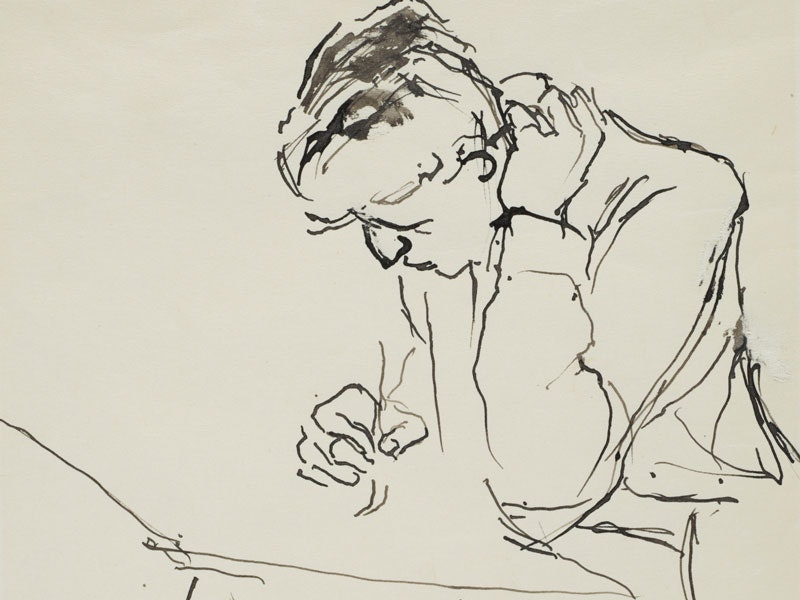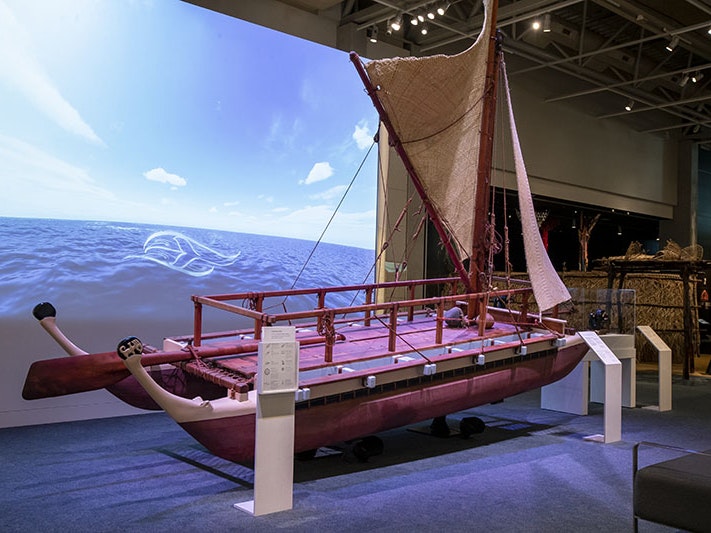
Planning a self-guided visit
All the practical information you need to know if you're planning on bringing your class for a visit at Te Papa.
Free museum entry for New Zealanders and people living in New Zealand
Open every day 10am-6pm
(except Christmas Day)
Free museum entry for New Zealanders and people living in New Zealand
Visit Rongomaraeroa, our contemporary marae on a self-guided visit to Te Papa. Explore the traditional and modern stories told through its design.
Duration: 15–20 minutes
Where: Rongomaraeroa, the marae, Level 4 (off Mana Whenua), or go up the ramp from Level 2
Visit Rongomaraeroa to see:
a unique marae concept and design, created by leading Māori artists
an authentic, living, working marae
modern art techniques used to tell traditional stories
a marae that belongs to everyone through a shared whakapapa and the mana of the taonga held in Te Papa's collections.
A visit to Rongomaraeroa supports the following topics:
Pūrākau – storytelling
Innovation and invention
Mathematics and society
New Zealand art and artists
Once you’ve booked your self-guided visit, bring your class and try the following activities.
Explore the wharenui right up to the back wall, and look at the designs.
Go outside to the waharoa, and look at all the different carvings on the gate.
Notice the flag flying. It signals the iwi in residence – the focus of Te Papa’s latest iwi exhibition.
Kawa differ among iwi, so the flag is a useful indicator of the kawa to be used on the marae during a pōwhiri (Māori welcoming ceremony).
Check out the art works in the Te Āti Awa gateway on your way back inside.
Use the topics below to explore and discuss Rongomaraeroa.
You don’t need to remove your shoes to visit Rongomaraeroa, but you are welcome to.
Book a guided education visit to get more support and expertise during your time at Te Papa.
Rongomaraeroa is your marae. What do you like about it?
How does Rongomaraeroa compare with Te Hau ki Turanga, the traditional wharenui in the nearby Mana Whenua exhibition?
Focus on the use of contemporary materials to tell traditional stories. Compare and contrast techniques and effectiveness.
Do you recognise any of the stories or people represented here? They include Ranginui and Papatūānuku, Māui, Paikea, and Tāne Mahuta. Can you see any others?
Can you recognise any of the jobs shown on the back panels of the wharenui? Do these relate to you and your family?
What do you think the colours represent? Why did the artist choose them?
The bright and beautiful colours are the same as those our ancestors would have seen in their own environment – in flora and fauna, native birds, clay and mud, rock, the rays of the sun, and rainbows.
What are the different parts of the wharenui?
The main parts are the tekoteko (head), the maihi (arms), the amo (legs), the tāhuhu (backbone), the heke (ribs), and the pou tokomanawa (central heart post).
What are the wharenui carvings made of? Why?
It was decided to use custom wood, or MDF, instead of using traditional native timbers, such as tōtara. As the carvings were mostly made by students, this meant precious native timbers would not be wasted if mistakes were made.
Can you find any repeating patterns or sequences? What shapes have been used? Are they two-dimensional or three-dimensional?
Rongomaraeroa is named after a place in the heavens where the atua (Māori gods) are said to meet in peace to discuss and settle issues.
The name of our wharenui, Te Hono ki Hawaiki, refers to the links to Hawaiki, the traditional homelands of Māori. The kinship groups it represents encompass all the iwi and other cultures whose taonga and stories are held at Te Papa.
When the stained-glass door (depicting Ranginui, the sky father) is opened, it pushes upwards away from the flooring (which depicts Papatūānuku, the earth mother), re-enacting the traditional Māori story of the separation of Ranginui and Papatūānuku.
The traditional story of Māui taming the sun is depicted in a carving on the maihi (arms) of the wharenui – Māui is an important figure in many Pacific cultures.
Along the roof of the meeting house you can see the story of the creation of the first woman, Hineahuone (the woman made from sand). She was made by her father Tāne Mahuta, the god of the forest, who is represented in the doorway of the wharenui.
Other stories depicted include that of Māui the trickster turning his brother-in-law, Irawaru, into a dog, and the story of Paikea the whale.
Aotearoa New Zealand’s other cultures are represented along the back wall of the wharenui. The changing relationship between Māori and Pākehā is portrayed inside the cupboards housed in the poutokomanawa (the central heart post of the meeting house).
Rongomaraeroa was created by master carver Cliff Whiting and the Māori advisory group to Te Papa, Ngā Kaiwawao. They came up with the idea of developing a fully functional marae that would embrace the concept of mana taonga (the role of communities in the understanding and care of collections) and the principles of the Treaty of Waitangi. The official opening was on 30 November 1997.
The stained-glass door was made by Robert Jahnke, and the flooring was designed by Kura Te Waru Rewiri.
The tukutuku (woven panels) on the walls were made by students from Toi Houkura, the Māori School of Design at the Tairāwhiti Polytechnic in Gisborne.
Visit the Mana Whenua exhibition on Level 4 to explore:
Te Hau ki Turanga wharenui, a meeting house from the Rongowhakaata iwi
Te Tākinga pataka kai, a food storehouse from the Ngāti Pikiao hapū
Mākōtukutuku wharepuni, a sleeping house from the Ngāti Hinewaka hapū.
Watch a Tales from Te Papa video about Te Tākinga pataka kai

All the practical information you need to know if you're planning on bringing your class for a visit at Te Papa.

Mana Whenua takes you on a stirring journey that explores and celebrates Māori as tangata whenua (the indigenous people) of Aotearoa New Zealand.
On now
Permanent exhibition
Exhibition Ngā whakaaturanga